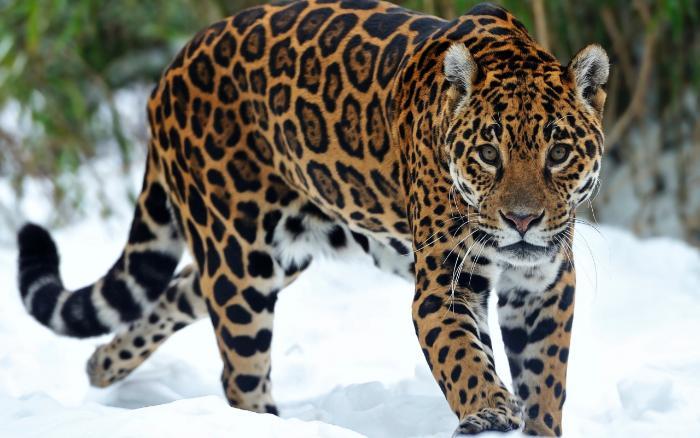
Ever since pre-Hispanic times the jaguar has moved freely between worlds, roaming between night and day, between earth and spirit realm.
For millennia this mysterious creature has been a feature of the Mexican desert and jungle as well as the country’s cosmologies, chiseled into circular stone calendars and the friezes of pyramids. The most famous living individual is currently El Jefe, a young jaguar who slips back and forth between northwestern Mexico and southwestern United States. With his quicksilver beauty and deadly fangs, he is, in some respects, the border incarnate. Yet soon the movements of this great symbol of duality will be curtailed. If the wall between Mexico and the United States is completed and turned into cement, centuries of dual citizenship will come to an end. The migration of over one hundred other species will suffer too.
Walls sever life currents. They slice through landscapes creating new demarcations that the local wildlife is forced to negotiate from one day to the next. Already numerous examples have emerged concerning wildlife in the Balkans, casualties of the razor wire fences erected by Hungary and Slovenia along their borders with Croatia to restrict the flow of refugees. Humans have found ways of bypassing the long metal jaws but deer, wolves, bears and lynx have not been as fortunate. Animals do not have countries; they have habitats. They forage, gallop, soar across invisible zones imposed by humans, and in doing so their destinies often become entangled with our own arbitrary lines. They exist outside of our measurements, except where our spaces overlap.
Migratory species truly are citizens of everywhere and nowhere. Their status shifts as they move from place to place, at the mercy of longitude and latitude, but by crossing a line they put their lives in jeopardy. Among the migratory species that travel to my native Mexico are the grey whale, the monarch butterfly and seven species of sea turtle. The Group of 100, an environmental organization founded by my parents in 1985, has campaigned for decades to protect them. Early in December grey whales arrive from the Bering and Chukchi Seas to breed in the lagoons of Baja California. The monarch butterfly sets out from Canada and the United States, gliding southward to overwinter in the high elevation oyamel forests in Mexico. Sea turtles appear each year to swim in Mexico’s waters and nest on beaches along its Pacific and Atlantic coasts. Needless to say, all these species have encountered adversity. In the case of the grey whale, in 1995 Mitsubishi and the Mexican government struck a deal to build the world’s largest solar saltworks on the shores of San Ignacio Lagoon, the whales’ main breeding ground; after five years of ardent campaigning, the project was finally cancelled. The monarch butterfly population continues to decline due to a loss in the US of milkweed (the only plant on which monarchs will lay their eggs, and the only one its caterpillars will eat), and the spraying of glyphosate herbicides, compounded by rapacious logging in the Monarch Butterfly Biosphere Reserve in Mexico. As for sea turtles, they are now officially protected but this doesn’t save them from the degradation of coastal environments by tourist developments and the impacts of climate change.
The only map migrants consult is the ancestral route in their heads. They carry around their own inner codes, a text written over millennia, which helps them navigate. Yet their paths are constantly intercepted by human behavior or interrupted by human structures. Some countries have sought to protect them, but they remain extremely vulnerable, and nowhere are animals more disenfranchised than in our oceans. One of the cruelest examples is the dolphin drive that takes place September through March in Taiji, Japan. Here animals are deflected from their vital destination and a natural feature is used as a trap. As large pods of dolphins and pilot whales migrate past the coastline in pursuit of shrimp, local fishermen appear and start banging long metal poles. As the cetaceans try to escape the wall of insufferable sound, they blunder into Taiji cove, which is rapidly sealed off. The “prettiest” individuals are chosen for aquariums and the rest, including all Risso’s dolphins, striped dolphins and pilot whales, are promptly slaughtered with a brutality that’s not even permitted in slaughterhouses. Most of the mercury-tainted meat, unfit for human consumption, winds up as pet food or fertilizer. For each dolphin in captivity, seventeen are killed in the wild. Despite years of international protests, the Japanese government refuses to ban the slaughter.
Because the slaughter takes place on Japanese territory there is little one can do to intervene. Yet admirable groups like Sea Shepherd and Dolphin Project go every year to document the killing. Sea Shepherd, the self-appointed guardian of marine creatures, uses direct action to intercept whatever illegal activity it can in international waters, that vast murky territory between shores where no one rules and anyone can be predator. The world needs more brave organizations to step in where local governments remain passive—and, even more urgently, an international ruling body that can intervene on behalf of certain species. During the Deluge, Noah’s Ark housed human and animal refugees. For 150 days, as the rest of the world was destroyed and renewed, humans and animals lived aboard this manmade structure in very close quarters, their fates thoroughly intertwined. Despite the mythical nature of this story, what people fail to see is that we are still in the same boat. Animals are our fellow citizens, yet citizens without papers, their interests obliterated by ours. Every geopolitical decision we make, every line drawn through a territory, will affect hundreds of species beyond our own.